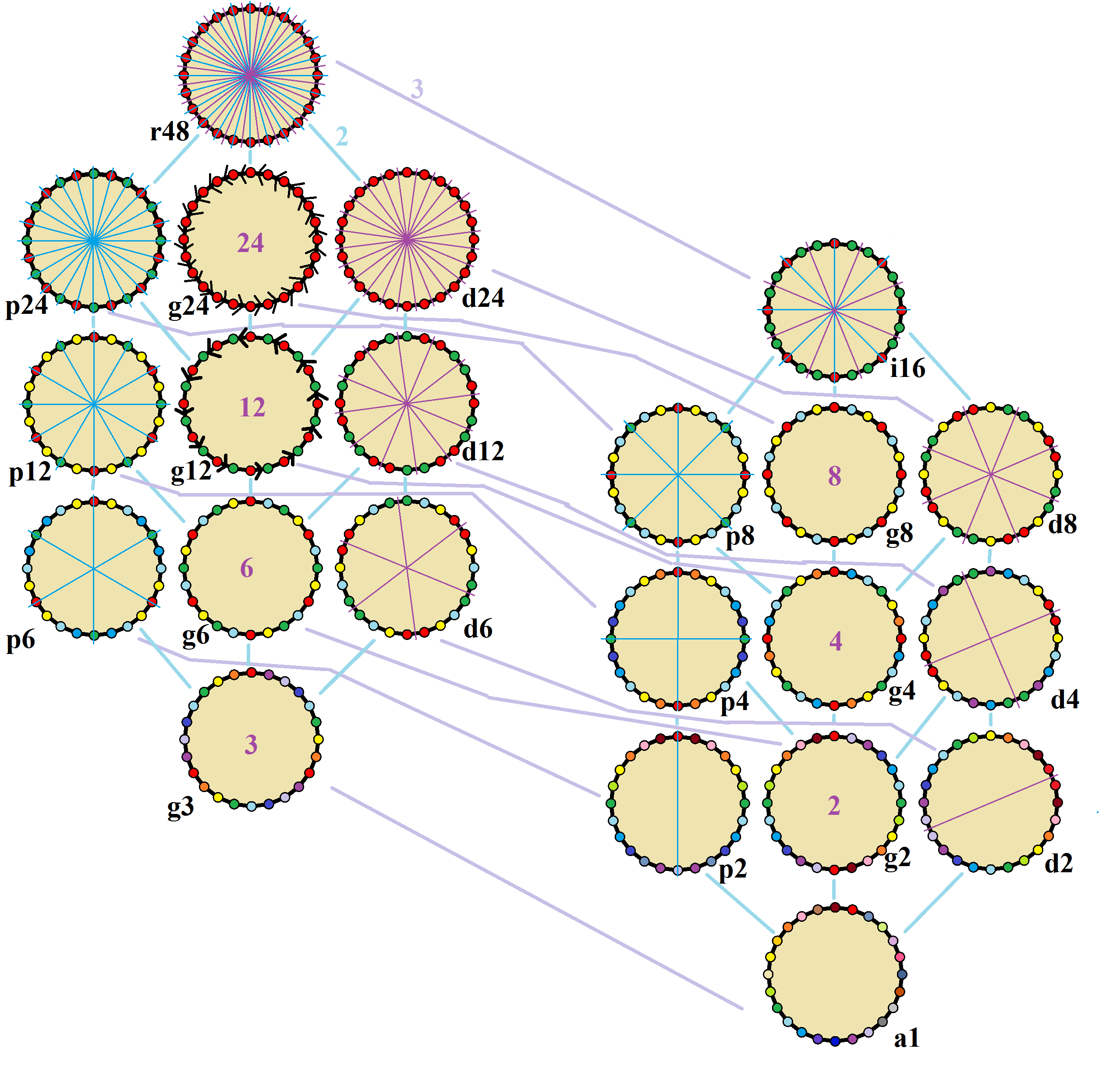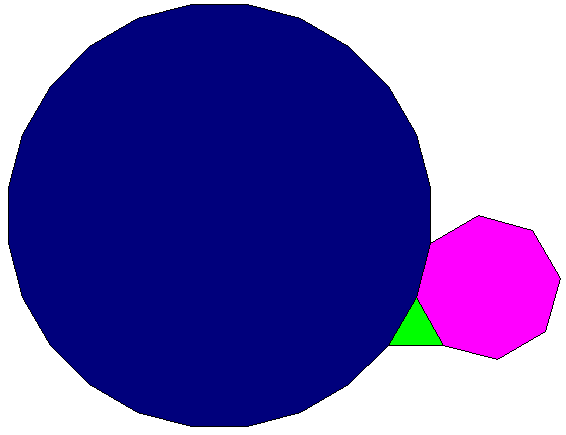icositetragon on:
[Wikipedia]
[Google]
[Amazon]
In
 The ''regular icositetragon'' has Dih24 symmetry, order 48. There are 7 subgroup dihedral symmetries: (Dih12, Dih6, Dih3), and (Dih8, Dih4, Dih2 Dih1), and 8
The ''regular icositetragon'' has Dih24 symmetry, order 48. There are 7 subgroup dihedral symmetries: (Dih12, Dih6, Dih3), and (Dih8, Dih4, Dih2 Dih1), and 8

A regular triangle, octagon, and icositetragon can completely fill a plane vertex. An icositetragram is a 24-sided
Naming Polygons and Polyhedraicosatetragon
{{polygons Constructible polygons Polygons by the number of sides
geometry
Geometry (; ) is, with arithmetic, one of the oldest branches of mathematics. It is concerned with properties of space such as the distance, shape, size, and relative position of figures. A mathematician who works in the field of geometry is c ...
, an icositetragon (or icosikaitetragon) or 24-gon is a twenty-four-sided polygon
In geometry, a polygon () is a plane figure that is described by a finite number of straight line segments connected to form a closed ''polygonal chain'' (or ''polygonal circuit''). The bounded plane region, the bounding circuit, or the two toge ...
. The sum of any icositetragon's interior angles is 3960 degrees.
Regular icositetragon
The '' regular icositetragon'' is represented bySchläfli symbol
In geometry, the Schläfli symbol is a notation of the form \ that defines regular polytopes and tessellations.
The Schläfli symbol is named after the 19th-century Swiss mathematician Ludwig Schläfli, who generalized Euclidean geometry to more ...
and can also be constructed as a truncated dodecagon
In geometry, a dodecagon or 12-gon is any twelve-sided polygon.
Regular dodecagon
A regular dodecagon is a figure with sides of the same length and internal angles of the same size. It has twelve lines of reflective symmetry and rotational sym ...
, t, or a twice-truncated hexagon
In geometry, a hexagon (from Ancient Greek, Greek , , meaning "six", and , , meaning "corner, angle") is a six-sided polygon. The total of the internal angles of any simple polygon, simple (non-self-intersecting) hexagon is 720°.
Regular hexa ...
, tt, or thrice-truncated triangle, ttt.
One interior angle in a regular icositetragon is 165°, meaning that one exterior angle would be 15°.
The area
Area is the quantity that expresses the extent of a region on the plane or on a curved surface. The area of a plane region or ''plane area'' refers to the area of a shape
A shape or figure is a graphics, graphical representation of an obje ...
of a regular icositetragon is: (with ''t'' = edge length)
:
The icositetragon appeared in Archimedes' polygon approximation of pi, along with the hexagon
In geometry, a hexagon (from Ancient Greek, Greek , , meaning "six", and , , meaning "corner, angle") is a six-sided polygon. The total of the internal angles of any simple polygon, simple (non-self-intersecting) hexagon is 720°.
Regular hexa ...
(6-gon), dodecagon
In geometry, a dodecagon or 12-gon is any twelve-sided polygon.
Regular dodecagon
A regular dodecagon is a figure with sides of the same length and internal angles of the same size. It has twelve lines of reflective symmetry and rotational sym ...
(12-gon), tetracontaoctagon (48-gon), and enneacontahexagon (96-gon).
Construction
As 24 = 23 × 3, a regular icositetragon is constructible using anangle trisector
Angle trisection is a classical problem of straightedge and compass construction of ancient Greek mathematics. It concerns construction of an angle equal to one third of a given arbitrary angle, using only two tools: an unmarked straightedge a ...
. As a truncated dodecagon
In geometry, a dodecagon or 12-gon is any twelve-sided polygon.
Regular dodecagon
A regular dodecagon is a figure with sides of the same length and internal angles of the same size. It has twelve lines of reflective symmetry and rotational sym ...
, it can be constructed by an edge-bisection
In geometry, bisection is the division of something into two equal or congruent parts, usually by a line, which is then called a ''bisector''. The most often considered types of bisectors are the ''segment bisector'' (a line that passes through ...
of a regular dodecagon.
Symmetry
 The ''regular icositetragon'' has Dih24 symmetry, order 48. There are 7 subgroup dihedral symmetries: (Dih12, Dih6, Dih3), and (Dih8, Dih4, Dih2 Dih1), and 8
The ''regular icositetragon'' has Dih24 symmetry, order 48. There are 7 subgroup dihedral symmetries: (Dih12, Dih6, Dih3), and (Dih8, Dih4, Dih2 Dih1), and 8 cyclic group
In group theory, a branch of abstract algebra in pure mathematics, a cyclic group or monogenous group is a group, denoted C''n'', that is generated by a single element. That is, it is a set of invertible elements with a single associative bina ...
symmetries: (Z24, Z12, Z6, Z3), and (Z8, Z4, Z2, Z1).
These 16 symmetries can be seen in 22 distinct symmetries on the icositetragon. John Conway
John Horton Conway (26 December 1937 – 11 April 2020) was an English mathematician active in the theory of finite groups, knot theory, number theory, combinatorial game theory and coding theory. He also made contributions to many branches ...
labels these by a letter and group order. The full symmetry of the regular form is r48 and no symmetry is labeled a1. The dihedral symmetries are divided depending on whether they pass through vertices (d for diagonal) or edges (p for perpendiculars), and i when reflection lines path through both edges and vertices. Cyclic symmetries in the middle column are labeled as g for their central gyration orders.
Each subgroup symmetry allows one or more degrees of freedom for irregular forms. Only the g24 subgroup has no degrees of freedom but can seen as directed edge
In mathematics, and more specifically in graph theory, a directed graph (or digraph) is a graph that is made up of a set of vertices connected by directed edges, often called arcs.
Definition
In formal terms, a directed graph is an ordered pa ...
s.
Dissection
Coxeter
Harold Scott MacDonald "Donald" Coxeter, (9 February 1907 – 31 March 2003) was a British and later also Canadian geometer. He is regarded as one of the greatest geometers of the 20th century.
Biography
Coxeter was born in Kensington to ...
states that every zonogon
In geometry, a zonogon is a centrally-symmetric, convex polygon. Equivalently, it is a convex polygon whose sides can be grouped into parallel pairs with equal lengths and opposite orientations.
Examples
A regular polygon is a zonogon if and ...
(a 2''m''-gon whose opposite sides are parallel and of equal length) can be dissected into ''m''(''m''-1)/2 parallelograms.
In particular this is true for regular polygons with evenly many sides, in which case the parallelograms are all rhombi. For the ''regular icositetragon'', ''m''=12, and it can be divided into 66: 6 squares and 5 sets of 12 rhombs. This decomposition is based on a Petrie polygon
In geometry, a Petrie polygon for a regular polytope of dimensions is a skew polygon in which every consecutive sides (but no ) belongs to one of the facets. The Petrie polygon of a regular polygon is the regular polygon itself; that of a reg ...
projection of a 12-cube
In geometry, a hypercube is an ''n''-dimensional analogue of a square () and a cube (). It is a closed, compact, convex figure whose 1- skeleton consists of groups of opposite parallel line segments aligned in each of the space's dimensions, ...
.
Related polygons

A regular triangle, octagon, and icositetragon can completely fill a plane vertex. An icositetragram is a 24-sided
star polygon
In geometry, a star polygon is a type of non-convex polygon. Regular star polygons have been studied in depth; while star polygons in general appear not to have been formally defined, certain notable ones can arise through truncation operations ...
. There are 3 regular forms given by Schläfli symbol
In geometry, the Schläfli symbol is a notation of the form \ that defines regular polytopes and tessellations.
The Schläfli symbol is named after the 19th-century Swiss mathematician Ludwig Schläfli, who generalized Euclidean geometry to more ...
s: , , and . There are also 7 regular star figures using the same vertex arrangement
In geometry, a vertex arrangement is a set of points in space described by their relative positions. They can be described by their use in polytopes.
For example, a ''square vertex arrangement'' is understood to mean four points in a plane, equ ...
: 2, 3, 4, 6, 8, 3, and 2.
There are also isogonal icositetragrams constructed as deeper truncations of the regular dodecagon
In geometry, a dodecagon or 12-gon is any twelve-sided polygon.
Regular dodecagon
A regular dodecagon is a figure with sides of the same length and internal angles of the same size. It has twelve lines of reflective symmetry and rotational sym ...
and dodecagram . These also generate two quasitruncations: t=, and t=. The Lighter Side of Mathematics: Proceedings of the Eugène Strens Memorial Conference on Recreational Mathematics and its History, (1994), ''Metamorphoses of polygons'', Branko Grünbaum
Branko Grünbaum ( he, ברנקו גרונבאום; 2 October 1929 – 14 September 2018) was a Croatian-born mathematician of Jewish descentskew polygon
Skew may refer to:
In mathematics
* Skew lines, neither parallel nor intersecting.
* Skew normal distribution, a probability distribution
* Skew field or division ring
* Skew-Hermitian matrix
* Skew lattice
* Skew polygon, whose vertices do not ...
with 24 vertices and edges but not existing on the same plane. The interior of such an icositetragon is not generally defined. A ''skew zig-zag icositetragon'' has vertices alternating between two parallel planes.
A regular skew icositetragon is vertex-transitive
In geometry, a polytope (e.g. a polygon or polyhedron) or a tiling is isogonal or vertex-transitive if all its vertices are equivalent under the symmetries of the figure. This implies that each vertex is surrounded by the same kinds of face in ...
with equal edge lengths. In 3-dimensions it will be a zig-zag skew icositetragon and can be seen in the vertices and side edges of a dodecagonal antiprism with the same D12d, +,24symmetry, order 48. The dodecagrammic antiprism, s and dodecagrammic crossed-antiprism, s also have regular skew dodecagons.Petrie polygons
The regular icositetragon is thePetrie polygon
In geometry, a Petrie polygon for a regular polytope of dimensions is a skew polygon in which every consecutive sides (but no ) belongs to one of the facets. The Petrie polygon of a regular polygon is the regular polygon itself; that of a reg ...
for many higher-dimensional polytopes, seen as orthogonal projection
In linear algebra and functional analysis, a projection is a linear transformation P from a vector space to itself (an endomorphism) such that P\circ P=P. That is, whenever P is applied twice to any vector, it gives the same result as if it wer ...
s in Coxeter plane
In mathematics, the Coxeter number ''h'' is the order of a Coxeter element of an irreducible Coxeter group. It is named after H.S.M. Coxeter.
Definitions
Note that this article assumes a finite Coxeter group. For infinite Coxeter groups, there a ...
s, including:
References
*Naming Polygons and Polyhedra
{{polygons Constructible polygons Polygons by the number of sides